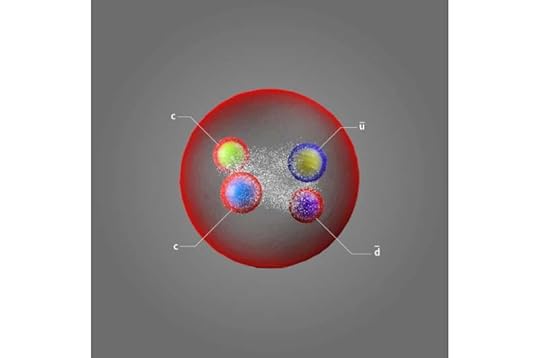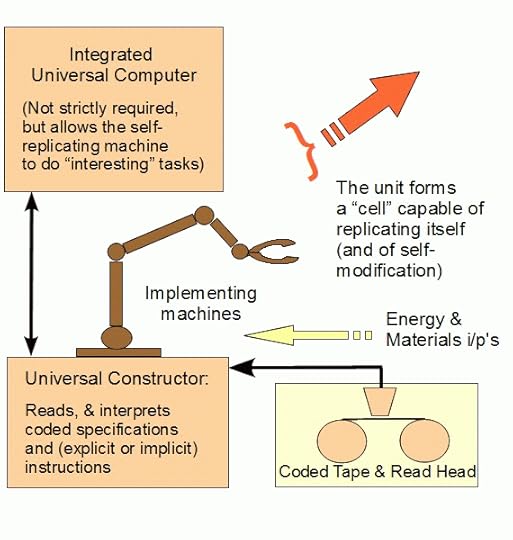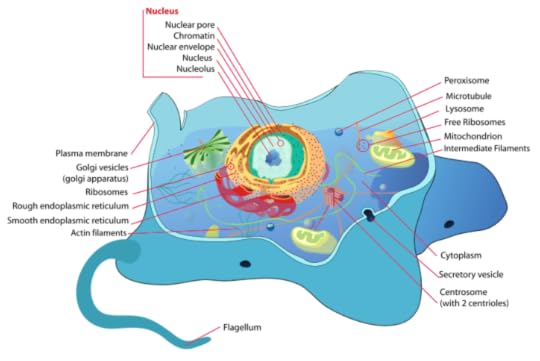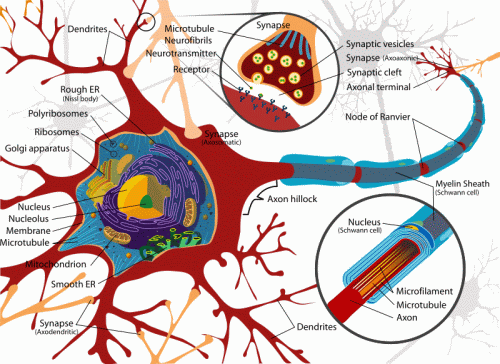Michael J. Behe's Blog, page 170
August 13, 2021
CERN: New exotic particle, tetraquark, discovered
Likely, the researchers say, to be the first of a newly discovered class of particles:

Quarks are the fundamental building blocks from which matter is constructed. They combine to form hadrons, namely baryons, such as the proton and the neutron, which consist of three quarks, and mesons, which are formed as quark-antiquark pairs. In recent years a number of so-called exotic hadrons—particles with four or five quarks, instead of the conventional two or three—have been found. Today’s discovery is of a particularly unique exotic hadron, an exotic exotic hadron if you like.
The new particle contains two charm quarks and an up and a down antiquark. Several tetraquarks have been discovered in recent years (including one with two charm quarks and two charm antiquarks), but this is the first one that contains two charm quarks, without charm antiquarks to balance them. Physicists call this “open charm” (in this case, “double open charm”). Particles containing a charm quark and a charm antiquark have “hidden charm”—the charm quantum number for the whole particle adds up to zero, just like a positive and a negative electrical charge would do. Here the charm quantum number adds up to two, so it has twice the charm!
The quark content of Tcc+, has other interesting features besides being open charm. It is the first particle to be found that belongs to a class of tetraquarks with two heavy quarks and two light antiquarks. Such particles decay by transforming into a pair of mesons, each formed by one of the heavy quarks and one of the light antiquarks. According to some theoretical predictions, the mass of tetraquarks of this type should be very close to the sum of masses of the two mesons. Such proximity in mass makes the decay “difficult,” resulting in a longer lifetime of the particle, and indeed Tcc+, is the longest-lived exotic hadron found to date.
The discovery paves the way for a search for heavier particles of the same type, with one or two charm quarks replaced by bottom quarks. The particle with two bottom quarks is especially interesting: according to calculations, its mass should be smaller than the sum of the masses of any pair of B mesons. This would make the decay not only unlikely, but actually forbidden: the particle would not be able to decay via the strong interaction and would have to do so via the weak interaction instead, which would make its lifetime several orders of magnitude longer than any previously observed exotic hadron.
CERN, “New exotic matter particle, a tetraquark, discovered” at Phys.org (July 29, 2021)
Let’s see what Sabine Hossenfelder has to say.
Note: There are also pentaquarks and hexaquarks, apparently. More later.
Copyright © 2021 Uncommon Descent . This Feed is for personal non-commercial use only. If you are not reading this material in your news aggregator, the site you are looking at is guilty of copyright infringement UNLESS EXPLICIT PERMISSION OTHERWISE HAS BEEN GIVEN. Please contact legal@uncommondescent.com so we can take legal action immediately.Plugin by Taragana
Building a Yacht — design in action
Here, we see a sped up time-lapsed snapshot succession view of the design and construction of a wooden yacht:
Here is another:
Now, let’s scale down to a canoe:
We thus see illustrated how . . .
design is intelligently directed configuration which makes advantageous, and ideally skilled and artistic, use of forces and materials in nature, economically, to achieve desired ends.
Now, let us follow Paley in his second step, in Ch 2 of his argument.
Suppose, that, in the course of its voyaging we were to notice that a particular yacht — having in it various stored plans, algorithms, assembler position- arm- effector devices, jigs, frames and devices etc, were to somehow construct another yacht of the same type.
That is, the yacht turned out to be a von Neumann kinematic self-replicator:

Would we now be dissuaded from our view that a Yacht is replete with signs that reliably point to its design? No.
As Paley pointed out, we might indeed infer that it is far more likely that the yacht we see has been part of the chain of self-replicating entities rather than being the direct product of observable external designers, but we would not surrender our design inference. Somewhere, behind the whole chain, would be a root-source of the contrivances, the apt functional organisation, the configuration to suitable ends. And indeed, the design of a self-replicating yacht is far more sophisticated than that of one without that additional capability.
Going further, suppose now that we were to see that the yacht did not merely copy itself but created a design family that gradually, across generations, adapted to various niches and specialisations in different zones across the world.
Would we now abandon our design inference?
Not at all, for such adaptability would be a further sign of the robustness of the design.
Of course, the living, self-replicating, metabolising cell . . .
 A typical animal cell, showing mitochondria
A typical animal cell, showing mitochondriais far more sophisticated and is a wonder of molecular nanotech that far exceeds our imagined self-replicating, adapting yacht.
It is adaptable, for example the neuron is an information-processing weighted sum gate:

So then, on what non question begging grounds would so many insist that such is a spontaneous, self creating entity? _________
Let us ponder where we have gone with origins science, why. END
Copyright © 2021 Uncommon Descent . This Feed is for personal non-commercial use only. If you are not reading this material in your news aggregator, the site you are looking at is guilty of copyright infringement UNLESS EXPLICIT PERMISSION OTHERWISE HAS BEEN GIVEN. Please contact legal@uncommondescent.com so we can take legal action immediately.Plugin by Taragana
August 12, 2021
A design inference with respect to Neanderthal art
At one time, it was an article of faith that Neanderthals could not do art. Much has changed:
A longstanding question among both evolutionists and Darwin-skeptics is whether Neanderthals were capable of symbolic artistic expression. This debate has gone back and forth for years and a new study in Proceedings of the National Academy of Sciences adds to the conversation by making a detailed analysis leading to a design inference that supports painting by Neanderthals. The study looked at the Cueva (Cave) de Ardales in Málaga, Spain which contains flowstones that have been stained by iron. A nice example of what these iron-stained flowstones look like can be seen here. The question is whether the iron-staining is the result of natural processes (e.g., flowing water depositing iron oxide) or deliberate painting using some kind of an ochre-based pigment. The study ultimately makes a design inference — the iron-staining is the result of real Neanderthal painting — as Science Daily reports …
In the technical paper they explain that the pattern of staining they observed is inconsistent with “natural geological processes.”
Casey Luskin, “Painting by Neanderthals? Study Makes a Design Inference” at Evolution News and Science Today (August 11, 2021)
Recall the 2012 bombshell when Neanderthal art was found, obliterating many certified lesser human theories.
Just let the paleontologists keep on making design inferences… Don’t spoil the fun.
The paper is closed access.
Copyright © 2021 Uncommon Descent . This Feed is for personal non-commercial use only. If you are not reading this material in your news aggregator, the site you are looking at is guilty of copyright infringement UNLESS EXPLICIT PERMISSION OTHERWISE HAS BEEN GIVEN. Please contact legal@uncommondescent.com so we can take legal action immediately.Plugin by Taragana
Animal adopts the lifestyle of a fungus
Ramisyllis is a bristle worm that lives inside the water passages of a sponge called Petrosia in a shallow reef off the coast of northern Australia. Its lone, unremarkable and rather lethargic head is buried deep in the sponge. Shortly after that things get weird.
Its body begins to branch repeatedly and without pattern. The legion resulting posteriors may protrude into the seawater through natural holes in the sponge and amble along its surface. One “small” sponge observed by scientists was festooned with more than 100 crawling worm fannies, sometimes more than 10 to a single opening. Although sponges are many remarkable things, sentient is not one of them, and that must surely be counted as a win here.
Further, each branch contains its own set of internal organs. According to thefirst detailed anatomical studyof these worms, published this year in the Journal of Morphology by a team from Spain, Australia and Germany, these organs are in no way different from that of the unbranched juvenile. They further found that the worm’s gut is continuous throughout the entire labyrinthine animal—but conspicuously empty. No sponge tissue has ever been found inside, nor food particles of any kind.
Jennifer Frazer, “One Head, 1,000 Rear Ends: The Tale of a Deeply Weird Worm” at Scientific American (August 8, 2021)
Animals adopt the lifestyles of plants (sea anemone?) and fungi but are there any instances of plants or fungi adopting the lifestyles of animals? If not, why not?
See also: Botanist Margaret Helder asks: How can a “simple” or “primitive” sponge surprise engineers with its optimal physics? Helder: A team of Italian and American scientists researching this topic declared that the sponges display “exceptional structural properties” which enable them to thrive. In fact, their study reveals “mechanisms of extraordinary adaptation to live in the abyss.”
Copyright © 2021 Uncommon Descent . This Feed is for personal non-commercial use only. If you are not reading this material in your news aggregator, the site you are looking at is guilty of copyright infringement UNLESS EXPLICIT PERMISSION OTHERWISE HAS BEEN GIVEN. Please contact legal@uncommondescent.com so we can take legal action immediately.Plugin by Taragana
At Mind Matters News: How the split brain emphasizes the reality of the mind
Fascinating research following up Roger Sperry’s work — which showed that the mind is not split when the brain is — has confirmed and extended his findings:
Michael Egnor: There has been some absolutely intriguing work done since Sperry that I think very clearly shows the existence of an immaterial aspect of the mind. Or, at least, it shows that the mind is, in fundamental ways, not splittable; it’s not material.
The first kind was done by Justine Sergent (1950–1994), a neuroscientist working at McGill University in Canada. Sergent extended Sperry’s work in the 1980s and what she did was absolutely brilliant. (01:05:54)
She took patients who had had split brain surgery and she would show either consonants or vowels in their visual fields. She would flash a k or an a — or a p or an i — in their visual fields. And she would ask them to push a button when they saw a vowel or a consonant.
So a patient would be sitting there and she’d be flashing consonants and vowels in different visual fields. She would ask them: When you see a vowel anywhere, left or right, push a button. So she’d do it a thousand times. (01:06:28)
She understood that, in people who had had a corpus callosotomy [severing the two halves of the brain], the right visual field was connected to the right arm and the left visual field was connected to the left arm … but there was no connection between the two hemispheres (halves) that control opposite sides of the body.
So a person pushing a button with the right hand had to be pushing the button — at least from a material standpoint –- based on what the left hemisphere had seen. That is what was in the right visual field. The right hand had no way of knowing what was in the left visual field because it was a disconnected hemisphere.
She found that, if she asked them, “Whenever you see a vowel anywhere, in either hemisphere, push this button with your right hand,” the right hand would push the button. Whether the vowel was seen by the right hemisphere or the left hemisphere. Even though the hemispheres were not capable of material connection with one another. (01:07:13)
So, she said, somehow the right hand knew what it was not connected to materially. If the vowel was put in the left visual field, the right hand had no way, metaphorically, to see it. But it still knew it. That happened with the other hand too. The left hand could respond to stimuli in the right visual field, even though there was no material connection that would allow information to get to the left hand from the right visual field. (01:08:15) News, “How the split brain emphasizes the reality of the mind” at Mind Matters News
Takehome: One investigator, whose work followed up and confirmed Roger Sperry’s, called her split brain findings “perceptual disconnection with conscious unity.”
Here are transcripts and notes for the first hour and six minutes:
The brain can be split but the mind can’t. Neuroscientist Roger Sperry found that splitting the brain in half does not split consciousness in half. It just gives you a rather interesting, but very subtle set of perceptual disabilities.
Neurosurgeon Michael Egnor has split patients’ brains, while treating serious epilepsy, and the results are not at all what a materialist might expect.
How philosopher John Locke turned reality into theatre His “little theater in the mind” concept means that you can’t even know that nature exists. It may just be a movie that’s being played in front of your eyes.
Aristotle and Aquinas’s traditional philosophical approach, Michael Egnor argues, offers more assurance that we can truly perceive reality.
How did Descartes come to make such a mess of dualism? Mathematician René Descartes strictly separated mind and matter in a way that left the mind very vulnerable. After Descartes started the idea that only minds have experiences, materialist philosophers dispensed with mind, then puzzled over how matter has experiences.
What’s the best option for understanding the mind and the brain? Theories that attempt to show that the mind does not really exist clearly don’t work and never did. Neurosurgeon Michael Egnor reviews the mind-brain theories for East Meets West: Theology Unleashed. He think dualism makes the best sense of the evidence.
How we can know mental states are real?
Mental states are always “about” something; physical states are not “about” anything. Michael Egnor argues that doing science as a physicalist (a materialist) is like driving a car with the parking brake on; it’s a major impediment to science.
Why neurosurgeon Mike Egnor stopped being a materialist atheist. He found that materialism is just not working out in science. Most propositions in basic science are based on mathematics and mathematics is not a material thing.
and
How science points to meaning in life. The earliest philosopher of science, Aristotle, pioneered a way of understanding it. Neurosurgeon Michael Egnor talks about the four causes of the events in our world, from the material to the mind.
You may also wish to read: Why the universe itself can’t be the most fundamental thing. Atheist biology professor Jerry Coyne is mistaken in dismissing my observation that proofs of God’s existence follow the same logical structure as any other scientific theory. (Michael Egnor)
Copyright © 2021 Uncommon Descent . This Feed is for personal non-commercial use only. If you are not reading this material in your news aggregator, the site you are looking at is guilty of copyright infringement UNLESS EXPLICIT PERMISSION OTHERWISE HAS BEEN GIVEN. Please contact legal@uncommondescent.com so we can take legal action immediately.Plugin by Taragana
A license to harm Asians?
How else to understand this?:
Racial and ethnic discrimination persist in science, technology, engineering and mathematics fields, including ecology, evolution and conservation biology (EECB) and related disciplines. Marginalization and oppression as a result of institutional and structural racism continue to create barriers to inclusion for Black people, Indigenous people and people of colour (BIPOC), and remnants of historic racist policies and pseudoscientific theories continue to plague these fields. Many academic EECB departments seek concrete ways to improve the climate and implement anti-racist policies in their teaching, training and research activities. We present a toolkit of evidence-based interventions for academic EECB departments to foster anti-racism in three areas: in the classroom; within research laboratories; and department wide. To spark restorative discussion and action in these areas, we summarize EECB’s racist and ethnocentric histories, as well as current systemic problems that marginalize non-white groups. Finally, we present ways that EECB departments can collectively address shortcomings in equity and inclusion by implementing anti-racism, and provide a positive model for other departments and disciplines….
Cronin, M.R., Alonzo, S.H., Adamczak, S.K. et al. Anti-racist interventions to transform ecology, evolution and conservation biology departments. Nat Ecol Evol (2021). https://doi.org/10.1038/s41559-021-01...
This is a license to harm Asians without necessarily helping anyone else because they are “overrepresented” in STEM. Any useful intervention would start with why more BIPOC students don’t consider STEM. In any such situation, more factors are at work than external prejudice.
Bur now, how sad that an intervention likely to do little more than entrench social conflict is the one that contains these words:
“The discipline of evolutionary biology has also been used at times to advance racist ideology. In fact, the writings of Charles Darwin, who is widely considered the father of evolutionary thought, contained racist ideas, including the belief that white Europeans were evolutionarily more advanced than the so-called savage races they colonized. Beginning in the late 1800s, the theory of natural selection was also misinterpreted in some intellectual circles to advance eugenics and social Darwinism, as well as to make apocryphal claims about race and gender. Since its publication, evolutionary theory has been distorted to fuel false claims of scientific racism in modern social and scientific literature, despite widespread and explicit scientific consensus to refute these ideas”
Yes, quite. And actually, Darwinism’s impact on racial minorities has been far worse than that:
This (above) is YouTube’s response to Biology of the Second Reich, John West’s documentary on the Second Reich’s genocide in Africa. If you go directly to YouTube, you can still see the film. The accuracy is not seriously disputed.
Look, we have been banging on about this for decades. And it has been a point of principle to ignore, ridicule, and misrepresent us, even though — by any reasonable standard — we are correct on the subject.
But when people won’t listen to reason, they may end up being forced to listen to unreason, which helps no one.
The paper is closed access.
See also: Darwinian biologist Jerry Coyne speaks out on a SciAm op-ed’s claims that denial of evolution stems from white supremacy. It seems obvious, on reflection, that Hopper’s piece is a disastrously clumsy effort on the part of Scientific American to get Woke. Darwinian evolutionary biologist Jerry Coyne thinks the mag is not just circling the drain but “approaching the drainhole.” To the extent that the editors couldn’t find someone who at least gets basic facts right, he has a point.
Historian Richard Weikart on acceptance of Darwinian evolution and racism …
Richard Weikart: I have done a good deal of research on this topic, and as it turns out, the vast majority of white supremacists today embrace Darwinian evolution and use it as evidence for their white supremacy.
Copyright © 2021 Uncommon Descent . This Feed is for personal non-commercial use only. If you are not reading this material in your news aggregator, the site you are looking at is guilty of copyright infringement UNLESS EXPLICIT PERMISSION OTHERWISE HAS BEEN GIVEN. Please contact legal@uncommondescent.com so we can take legal action immediately.Plugin by Taragana
August 11, 2021
3X+1 is an unexpectedly weird math problem
The Collatz Conjecture is the simplest math problem no one can solve — it is easy enough for almost anyone to understand but notoriously difficult to solve.
Toward the end: “If anything it shows that all the things we can solve are miracles.”
More on the Collatz Conjecture.
Hat tip: Heather Zeiger
See also: Things exist that are unknowable: A tutorial on Chaitin’s number
and
Yes, you can manipulate infinity in math. The hyperreals are bigger (and smaller) than your average number — and better! (Jonathan Bartlett)
Copyright © 2021 Uncommon Descent . This Feed is for personal non-commercial use only. If you are not reading this material in your news aggregator, the site you are looking at is guilty of copyright infringement UNLESS EXPLICIT PERMISSION OTHERWISE HAS BEEN GIVEN. Please contact legal@uncommondescent.com so we can take legal action immediately.Plugin by Taragana
Botanist Margaret Helder asks: How can a “simple” or “primitive” sponge surprise engineers with its optimal physics?
Live glass sponges are a relatively recent discovery:
It is not every day that one discovers living organisms which were formerly known only as fossils. One such remarkable story took place off the northwest coast of British Columbia (Canada) where some glass sponge reefs were first detected. Canadian scientists mapping the seafloor near Vancouver Island came across some signals suggesting that there were huge, mysterious mounds on the sediments below them. That was 1987. Upon further investigation, the scientists discovered that the mounds were, in fact, reefs made up of glass sponges. The reefs, in 200 meters of water, covered about 1000 square kilometers of sea floor and rose as high as a seven-story building. The really remarkable thing, however, is that these glass sponge reefs had formerly been known only as fossil deposits such as enormous cliffs stretching on land from Portugal to Romania. According to standard geological dating, these reefs are found in rock strata identified as Triassic to Eocene.1 No such reefs were known in the sea today. But here they were, reefs made up of some living creatures and some skeletons of once living specimens…
It is obvious that the glass sponges live in a habitat which involves special challenges. They mostly grow as solitary individuals or small clumps at depths of 1500-3000 feet (450-900 m). The body is anchored to soft sediments on the sea floor, not the best substrate for maintaining one’s position. The problem is compounded by the average water currents in the first 30 cm or 12 inches above the sea bed. Here the currents move at 0 – 11 cm per second or about 6 m to 20 feet per minute.15 How do these animals survive in this habitat? A team of Italian and American scientists researching this topic declared that the sponges display “exceptional structural properties” which enable them to thrive. In fact, their study reveals “mechanisms of extraordinary adaptation to live in the abyss.”16 They were able to make these statements because they had carried out experiments on this capability.
Margaret Helder, “Glass sponges: Lessons from the deep” at Creation–Evolution Headlines
Move along, folks. No design to see here.
Stasis: Life goes on but evolution does not happen
Copyright © 2021 Uncommon Descent . This Feed is for personal non-commercial use only. If you are not reading this material in your news aggregator, the site you are looking at is guilty of copyright infringement UNLESS EXPLICIT PERMISSION OTHERWISE HAS BEEN GIVEN. Please contact legal@uncommondescent.com so we can take legal action immediately.Plugin by Taragana
Asked at the Journal of Theoretical Biology: Is the cell REALLY a machine?
Biologist argues no:
Highlights
•Self-organization plays a key role in specifying the cellular architecture.
•Most proteins are functionally promiscuous and interact opportunistically.
•Directed movement occurs in the absence of design by generating order out of chaos.
•The non-genetic heterogeneity of cell populations implies that every cell is unique.
•Physics, not engineering, proves most helpful in understanding cellular complexity.
Abstract: It has become customary to conceptualize the living cell as an intricate piece of machinery, different to a man-made machine only in terms of its superior complexity. This familiar understanding grounds the conviction that a cell’s organization can be explained reductionistically, as well as the idea that its molecular pathways can be construed as deterministic circuits. The machine conception of the cell owes a great deal of its success to the methods traditionally used in molecular biology. However, the recent introduction of novel experimental techniques capable of tracking individual molecules within cells in real time is leading to the rapid accumulation of data that are inconsistent with an engineering view of the cell. This paper examines four major domains of current research in which the challenges to the machine conception of the cell are particularly pronounced: cellular architecture, protein complexes, intracellular transport, and cellular behaviour. It argues that a new theoretical understanding of the cell is emerging from the study of these phenomena which emphasizes the dynamic, self-organizing nature of its constitution, the fluidity and plasticity of its components, and the stochasticity and non-linearity of its underlying processes.
Daniel J. Nicholson, “Is the cell really a machine?” at Journal of Theoretical Biology Volume 477, 21 September 2019, Pages 108-126
The paper is closed access.
“Machine” is at best an analogy to certain aspects of cells. Readers write to say that, unlike machines, cells seek their own good (inherent teleology).
Copyright © 2021 Uncommon Descent . This Feed is for personal non-commercial use only. If you are not reading this material in your news aggregator, the site you are looking at is guilty of copyright infringement UNLESS EXPLICIT PERMISSION OTHERWISE HAS BEEN GIVEN. Please contact legal@uncommondescent.com so we can take legal action immediately.Plugin by Taragana
August 10, 2021
Proof of the power of sheer randomness
Yer news hack (O’Leary for News) has been light posting because of relatives visiting. Back soon. Meanwhile, went to the beach with them yesterday and snapped a picture of the awesome power of pure randomness.
Look how the sea just deposited these pebbles here:

Randomness is not a scientific explanation. Eric Holloway: We can never know if anything is truly random. Three different computer scientists have proven that randomness is unprovable. The only thing we can know is that something is not random.
Copyright © 2021 Uncommon Descent . This Feed is for personal non-commercial use only. If you are not reading this material in your news aggregator, the site you are looking at is guilty of copyright infringement UNLESS EXPLICIT PERMISSION OTHERWISE HAS BEEN GIVEN. Please contact legal@uncommondescent.com so we can take legal action immediately.Plugin by Taragana
Michael J. Behe's Blog
- Michael J. Behe's profile
- 219 followers



